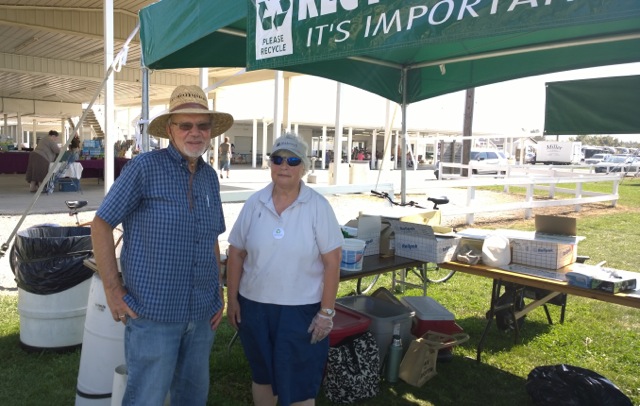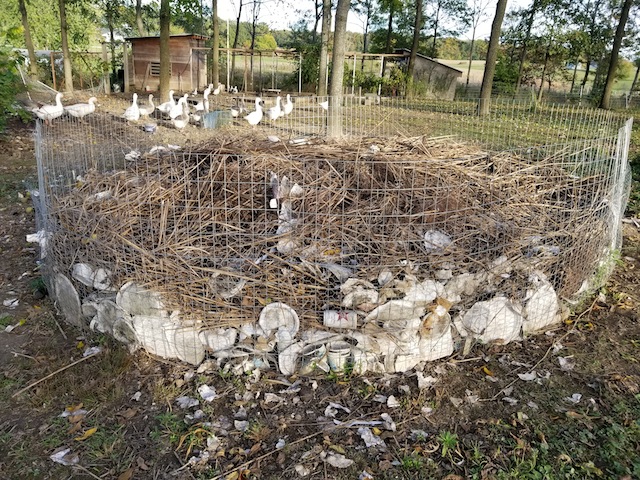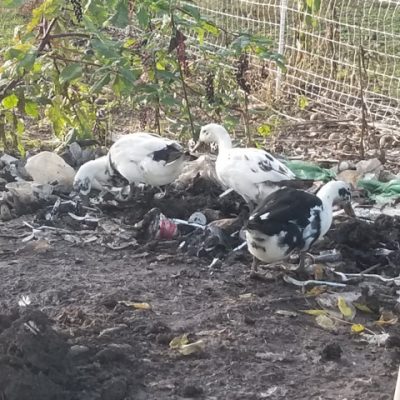
Recycling Coordinator David Gerber, Eighth Street Mennonite Church, with Volunteer Helene Hoover of Benton Mennonite Church at the recycling headquarters for the Michiana Mennonite Relief Sale.
As recently as 2009, all of the waste generated by the thousands of guests at the Michiana Mennonite Relief Sale, Goshen, Ind., went into the trash except for a few aluminum cans. In September 2017, the sale kept 48 cubic yards of waste[1] out of the landfill. Stacked end to end, those cubic yards would be almost as long as three semi trailers. Or you could fill about 250 bathtubs with that much trash.
Where does all the trash go?
What happens to the napkin received with an apple fritter, the gallon cans that held the cheese sauce and the samosa a child couldn’t finish? Plastic and metal recyclables are the easiest to manage because Borden, a local waste company, provides recycling containers for free and collects them. Cardboard boxes form one of the largest single types of waste. These are flattened and sent to Borden as well. The company even takes the plastic film from quilts.
Starting with a pilot project in 2013, compostable paper plates, cups and take-out containers have replaced Styrofoam. This enables the sale to compost food waste. Steve Shantz, a local landowner, takes the compost, lets it rot down inside a wire enclosure and then in the spring, turns his ducks loose to forage for the many red wigglers that have been busy decomposing the food. Shantz has three acres and a commitment to making his land productive either by producing food, sequestering carbon or providing habitat.
“Composting is part of that,” he says.

Food waste and paper products decomposing in the Shantz duck yard. The compost is fenced and covered with reeds to prevent blowing
The Elkhart County Fairground takes the remaining trash, runs it through a trash compactor and sends it to the landfill. Fairground personnel used to come through in the middle of the relief sale to empty trashcans, but since recycling reduced the amount of trash, they can wait until the end of the sale. Many fewer trash barrels are needed.
About 45 volunteers provide the labor needed in five two-hour shifts. Their tasks include setting up the recycling stations, coaching people to sort their waste and cleaning up afterwards.
Recycling practices
How did the sale accomplish this level of recycling when greening a large event can seem overwhelming? Leaders of the effort–Shantz, Eileen Saner and David and Fern Gerber, all of Goshen, Ind.–describe a process that evolved each year with plenty of hands-on learning along the way. Here are some of the practices that contributed to ongoing success:
Embrace a vision for caring for the earth
In the early 2000s before any recycling efforts began, a group of people who were concerned about environmental issues began meeting. Earth Group discussions ranged from the biblical and theological basis for environmental stewardship to practical local issues and what to do about them. Recycling at the relief sale came up repeatedly over several years.
In 2010, the Earth Group agreed to take over trash collection at the relief sale in hopes of finding ways to recycle. While the group eventually disbanded, several of its members—Shantz and Saner among them—continued to work with relief sale recycling over the years, providing a backbone of leadership, continuity and vision that attracted other like-minded people. Speaking with them, one senses there is a deeply held “why we’re doing this” underlying the work.
Start with small projects
The Gerbers have headed up relief sale recycling since 2013. David Gerber’s number one piece of advice for beginners is to start small. “Pick one area of the sale that you can manage. Don’t try to do the whole thing at first,” he says.
At Michiana’s sale, the pancake breakfast, haystack supper and haystack breakfast were good starting points because many people eat at once and use a single exit. In contrast, the ethnic food tent has many exit routes, making recycling harder to enforce. The pancake breakfast was the pilot project for the larger composting efforts now in place.

A volunteer breaks down cardboard at the end of the relief sale.
Work closely with the relief sale board, food committee and food vendors
The Gerbers appreciate the encouragement they have received from the relief sale board and its chair, John Martens.
“He was the one who encouraged us to move from the minimal recycling being done to what we do today,” David Gerber says.
The move from Styrofoam to compostable food containers was a difficult one because of the added expense for the sale. The first year, Eighth Street Mennonite Church, Goshen, Ind., volunteered to pay the difference between compostables and Styrofoam. After seeing how the composting worked, the sale board made the commitment to continue with the paper products.
The Gerbers appreciate the ways that the relief sale’s food committee has supported their work. “They got on our side and went to bat for us,” David Gerber said, recalling an incident when a company did not follow instructions and supplied milk in non-recyclable containers two years in a row. The second year, the food committee refused to accept the shipment.
“One thing that has evolved during our time is that we are working more directly with the vendors,” Fern Gerber explained. This helps the recycling crew know what kind of trash a particular vendor will create and prepare in advance to deal with challenges such as packaging from raw meat. On the Friday before the sale, the Gerbers visit each booth, encourage the vendors to recycle and leave their card and phone number.
“Year after year, people know what to expect. Vendors are becoming involved and responsible for their wastes,” Fern added.
Communicate with the public
Initially, recycling at the relief sale was a foreign idea to attendees. Over time, people began getting the hang of it, but some are still flummoxed by the idea of separating recyclables from trash or distracted by conversation. In high traffic areas with a single exit, the Gerbers post volunteers by the bins to assist.
“We try to do it in a friendly way. We try not to be punitive,” Fern Gerber says.
Recycling records indicate continual efforts to improve signage. In 2016, people waiting in line at the haystack supper and pancake breakfast could view a large sign illustrating the composting process.
Shantz would like the public to understand the consequences of putting utensils, creamer cups and other plastic items into the compost. While the utensils can be recycled, they do not break down in his cold process compost and need to be picked out. Sometimes he finds what he calls “goofy stuff” in the compost—such as a $10 bill, a shoe, a scarf and a package of condoms.

Ducks forage for worms in the compost from the relief sale. Note misplaced plastic cup and forks that do not break down. Please sort trash carefully.
Be reflective
Not everyone keeps notes on their volunteer activities, but the Michiana Relief Sale recycling has benefitted from leaders with an archival bent.
The Gerbers’ careful notes enabled the endeavor to learn from experience and improve. For example, a report from 2016 includes a chart showing how many cubic yards of waste were composted and recycled from 2013 onward. The numbers jump from 12 to 25 to 34 to 40 to 48 cubic yards. The same report describes exactly how the washing station for empty tins was set up and the pitfalls associated with unlabeled containers.
Saner, a former librarian, was able to produce Earth Group minutes from 2007 and stats detailing the number of bags of compost the pancake breakfast produced in 2013. These kinds of records will enable future volunteers to step into new roles easily.
Onward!
Scott and Kate Friesen-Kempf will coordinate the Michiana Mennonite Relief Sale recycling efforts in 2018. Kate says she was impressed by the fact that the recycling effort is not the project of any one church, but incorporates committed people from all over.
“I never realized that relief sale recycling happened on such a large scale,” she said. §
Resources
Kim Robson, Why Styrofoam is so Bad for the Environment, Green Mom Site.
Impacts of Styrofoam, Washington University in St. Louis
Green Festivals and Events Guide: A How-to, Icarus Foundation
[1] Not compacted.
